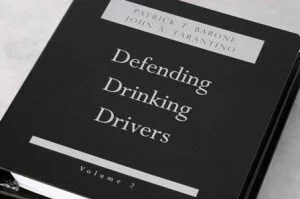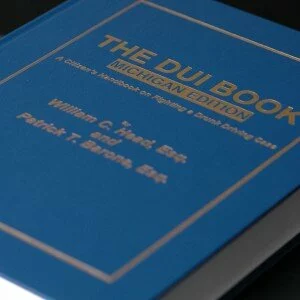It is possible for a person arrested for drunk driving who is suffering from GERD to have a breath test result that is way too high. So what does ”way too high” really mean? It’s impossible to say, but with GERD the breath test result could be as much as 100% too high. It is more likely however that the breath test result is closer to between 20% and 80% too high.
GERD is an acronym meaning “Gastroesophageal Reflux Disease.” The common name for this is condition heart burn. The reason the breath test result is falsely high is because with GERD the machine, called in Michigan the DataMaster, is not measuring breath alcohol or deep lung air.
Instead, the breath test machine is measuring alcohol gases or vapors erupting from the stomach into the mouth which are then blown into the DataMaster. In this case the DataMaster is measuring stomach gas alcohol rather than breath alcohol collected from a sample of deep lung air.
Another problem occurs when the machine measures mouth alcohol rather than deep lung air. In this case the raw alcohol erupts into the mouth, thereby causing a false DataMaster result. Either way, GERD causes a breath test result that is falsely high.
If you have been arrested for DUI, have been diagnosed with GERD and you think that your GERD may have impacted the DataMaster result, then it is important to substantiate this diagnosis. In other words, you must undergo confirmatory testing.
The first confirmatory test is called an endoscopy. According to Wikipedia, “endoscopy means looking inside and typically refers to looking inside the body for medical reasons using an instrument called an endoscope.” During this test, a small catheter is placed into the esophagus and photographs are taken of the esophagus and the Lower Esophageal Sphincter (LES).
The more detailed way to describe this is as follows: “Esophagogastroduodenoscopy (EGD) (a form of endoscopy) involves insertion of a thin scope through the mouth and throat into the esophagus and stomach (often while the patient is sedated) in order to assess the internal surfaces of the esophagus, stomach, and duodenum.” Id.
After the test is complete, the specialist will look at these results (including photographs) to determine if there is evidence of damage caused by acid erupting into the esophagus from the stomach. The photographs will also be inspected for evidence of a possible hiatal hernia, which “increases the likelihood of GERD due to mechanical and motility factors.” Id.
If the EGD reveals that the LES is open, then the patient has a Gastroesophageal Reflux Disease (GERD) condition with a constant reflux/regurgitation. This is significant as it pertains to breath testing because with an open LES there is essentially an uninterrupted or open chamber beginning in the stomach, continuing into and through the throat and finally into the mouth.
With this condition stomach gases are able to escape (back flow/regurgitate) into the mouth from the stomach. The defective sphincter (LES) allows the gases/molecules, including of course alcohol molecules, to leave the stomach and pass into the mouth. During a breath test these alcohol gasses mix with the deep lung air, which also contains alcohol, and the accumulated gasses are “read” by the machine in a cumulative fashion thereby causing a false breath test result.
Another problem with GERD is the potential of raw alcohol to erupt from the stomach into the mouth. While it is true that mouth alcohol will dissipate rapidly the problem is that with an open LES the patient suffers from a condition that may produce constant reflux/regurgitation. If this condition exits, and if the conditions during the breath test are appropriate, then a 15 minute observation period will not stop a false high breath test result.
The presence or absence of this condition is confirmed by a second test, called a 24 hour pH test (pH denoting the acidity level in a person). According to Wikipedia, Esophageal pH monitoring is the current gold standard for diagnosis of Gastroesophageal Reflux Disease (GERD). It provides direct physiologic measurement of acid in the esophagus and is the most objective method to document reflux disease, assess the severity of the disease and monitor the response of the disease to medical or surgical treatment. Id.
Esophageal pH monitoring is being performed using one of the following three techniques:
- Single sensor pH monitoring using a pH catheter
- Dual sensor pH monitoring using a pH catheter
- Wireless pH monitoring using Bravo pH capsule
The duration of the test is 24 hours in the first and second techniques and 48 hours or more for the Bravo capsule. Id.
Unless the Bravo capsule is used an esophogeal pH test requires a catheter to be inserted through the nostril, into the throat, and down into the esophagus where it is stopped slightly above the LES. The catheter remains in the subject for 24 hours. The recorder monitors every episode of reflux/regurgitation during this time period.
If the appropriate medical tests are given and if they confirm the existence of GERD and the extent of the problem, then you will have an excellent potential defense to the breath test.

Barone and Dr. A. W. Jones - 2008.
This defense is not without its detractors, and you should expect the government lawyer to argue that the slope detector will cure this breath testing problem. To substantiate this claim, the government relies on a single, limited study published in the Journal of Forensic Science nearly ten years ago. The author of this study was none other than A.W. Jones. This study used only ten subjects, and only four of whom were definitely experiencing GERD effects at the time of the study. The fact that the authors concluded from this very limited study that a false breath test was “highly improbable,” only underscores that an erroneous result is certainly possible.
In a later article that appeared in the DWI Journal: Law & Science, Dr. Jones explains his 1999 study cited above. In this subsequent article Dr. Jones acknowledges that the DataMaster’s slope detection is inadequate to detect mouth alcohol. Dr. Jones reiterated this position in Fitzgerald, Intoxication Test Evidence, where he again acknowledges that GERD can cause false results.
In another more recent DWI Journal: Law & Science article, published in 2007, Jones indicated:
It is widely known that many breath alcohol instruments currently used by law enforcement worldwide are inept at detecting mouth alcohol under some circumstances. For example, there is no published evidence that the more dangerous form of mouth alcohol, namely that which might erupt from the stomach in connection with a burp, belch, or regurgitation is successfully detected and distinguished from alcohol originating from the lungs.
Id. at Pg. 2.
Thus, even Jones, the author of the study relied upon by the government, has acknowledged that slope detectors don’t work well enough to detect mouth alcohol that originates from GERD.
The so-called GERD defense has been recognized as a valid breath test defense in drunk driving cases in at least one state. In People v Bonutti, 212 Ill 2d 182; 817 NE2d 489 (2002), the Illinois Supreme Court recognized the potential danger that GERD could have in creating a false breath reading. The Bonutti Court upheld the suppression of breath test results of a defendant who was suffering from GERD at the time of test.
There, the court said:
In closing, we note that this is not the type of suppression case in which clear evidence of criminal wrongdoing is withheld from the fact finder because of a prosecutorial misstep. Section 1286.310(a) [of the breath-testing administrative rules] exists because regurgitation within 20 minutes of a breath-alcohol test can render a false positive. In other words, a lack of compliance with section 1286.310(a) has the potential to create criminals out of people who are not. This is not a “technicality,” and it is not a contingency that this court will countenance.
Bonutti at 192; 817 NE2d at 495
While the Bonutti decision was subsequently superseded by statute, which precludes suppression of a breath test result from regurgitation short of a test-taker’s vomiting, a defendant is still permitted to argue the validity of the test results using expert testimony. See, People v Lindmark, 381 Ill App 3d 638, 660; 887 N.E.2d 606, 625 (2008).
WARNING: If you suffer from GERD and have been arrested and charged with OWI based on UBAL (unlawful bodily alcohol level) you could be wrongly convicted of drunk driving. Contact the Barone Defense Firm today for your FREE consultation.
 Mr. Barone is the author of the well known and well respected two volume treatise on the law and science of drunk driving. This national book is relied on by DUI lawyers around the Country who use it to improve their skill in the defense of drinking drivers.
Mr. Barone is the author of the well known and well respected two volume treatise on the law and science of drunk driving. This national book is relied on by DUI lawyers around the Country who use it to improve their skill in the defense of drinking drivers.





{ 2 comments… read them below or add one }
Is GERD a valid defense in a DUI? Can a 100 lb. woman from India with Gerd who blew A .14 ON the breathalyzer be falsely elevated due to Gerd, who had 2 glasses of 5 oz. of wine during a 3 hour period? Can there still be reflux even if the officer observed her for 20 minutes without noticing belching? What would her actual BAC be if she did consume this amount of alcohol ?
Reply
Yes, GERD is most certainly a valid defense, but how it may apply to a given legal/DUI situation is highly fact dependent. If the attorney handling the matter wants to contact me to consult on the given issue, I am will be happy to discuss this with him/her but I’d prefer not to offer an opinion without knowledge of the full facts of the case…In any event, these are matters to be put to the retained attorney who can determine if GERD would be a productive and possible defense issue to raise.
Reply